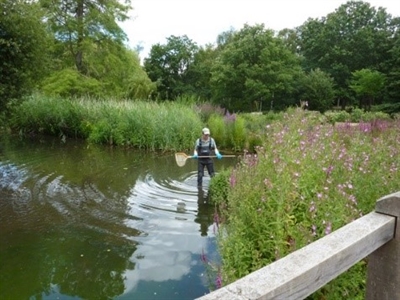Good news for the Isabella Plantation's ponds and streams!
By Jo Scrivener and Sam Wilkinson
£120k funding has enabled TRP to carry out substantial improvements to Isabella Plantation’s ponds and streams.
Now, some 2 years after the work was completed, a survey has confirmed that the Plantation’s Ponds are flourishing and far removed from their former degraded condition.
The Funding
As part of the £1.7m Heritage Lottery and, Big Lottery funded, Isabella Plantation Access Project, TRP was awarded almost £120k by SITA Trust (a not-for-profit company operating within the government’s Landfill Communities Fund) to make extensive improvements to the Plantation’s network of ponds and streams. The Friends contributed £6k in partial match funding.
To inform the original funding application to SITA Trust, The Royal Parks commissioned a survey of all three ponds in the Plantation. The survey assessed water quality and silt loadings and in addition to this, data was gathered on the plant and animal communities present to score each pond on its ecological quality. The findings supported our proposals to enhance the ecology of the ponds and streams and helped to secure the necessary funding from the Trust.
The Improvements
In the autumn and winter of 2012/13 TRP was able to deliver the following improvements:
- removal of large quantities of excess silt (nearly 2,400m3) from the ponds
- enhancements to the marginal planting around the ponds and notably the creation of substantial areas of reed bed in Peg’s Pond – a habitat of principal importance in the UK
- removal of large numbers of common carp
- reduction of over-shading to Peg’s Pond and the interconnecting streams
- in-channel improvements to the streams to retain deeper water areas and vary the flow characteristics
- control of non-native invasive species
- addition of submerged woody debris to Still Pond to create invertebrate habitat
The Results
TRP made a commitment to funders to evaluate the success of the work by carrying out repeat surveys of the ponds once they had had time to settle down and establish. The 2015 survey revealed that, in little over two years, the Plantation’s Ponds are flourishing and far removed from their former degraded condition.
All ponds have shown a marked improvement in water and habitat quality and as a result biodiversity has significantly improved. The ecological quality score for Thomson’s Pond increased from 33% in 2011 to 72% in 2015 and the pond showed a greater range of invertebrates such as bugs, dragonflies and damselflies. A particular highlight is the change to Peg’s Pond which is now in ‘good’ ecological condition with a score of 89% (formerly 50%) and considered to be a ‘priority pond’ under Pond Conservation’s PSYM (Predictive SYstem for Multimetrics) classification. Peg’s Pond has benefited from the addition of reed beds which can support a diverse range of species from the interesting to the rare. This unique habitat not only provides welcome cover for existing water birds including the kingfisher but has attracted new species such as little grebe and seen the return of reed warbler which hadn’t been recorded since 2007.
The changes to Still Pond were minimal to retain its character as a reflective pool mirroring the tree canopy above and the spectacular seasonal display of ornamental rhododendrons and azaleas. However, the addition of submerged deadwood has added ecological value to this pond and provides an opportunity for specialised aquatic invertebrates to establish over time.
The pond works have benefited a range of existing species such as smooth newt, common frog, southern hawker dragonfly, large red damselfly and with careful management the enhanced habitat will be colonised or used by other new species, maybe even the great crested newt – a protected species found only in a couple of locations in Richmond Park. The improvements to ponds and streams and particularly the creation of new habitat such as reed beds have helped to achieve local and regional Biodiversity Action Plan targets.
The transformation is immediately noticeable to visitors; the ponds are teaming with life now that the murky water is clear. Their natural quality and aesthetic appeal has also been enhanced by marginal and aquatic planting.
The project has significantly improved access to and around ponds with the addition of natural gravel paths, decked areas and stepping stones. Benches have also been carefully placed to allow visitors to enjoy the ponds and their wildlife. New interpretation also aims to increase public awareness and understanding of these special habitats.
Working in Partnership
Partnership working was an integral part of the project and early on TRP received vital support and advice from a number of organisations including Natural England, Froglife, the Wildfowl and Wetlands Trust and the London Borough of Richmond upon Thames, for which we are grateful.
Jo Scrivener is Assistant Park Manager and led the IPAP project
Sam Wilkinson is Ecology Officer for The Royal Parks


